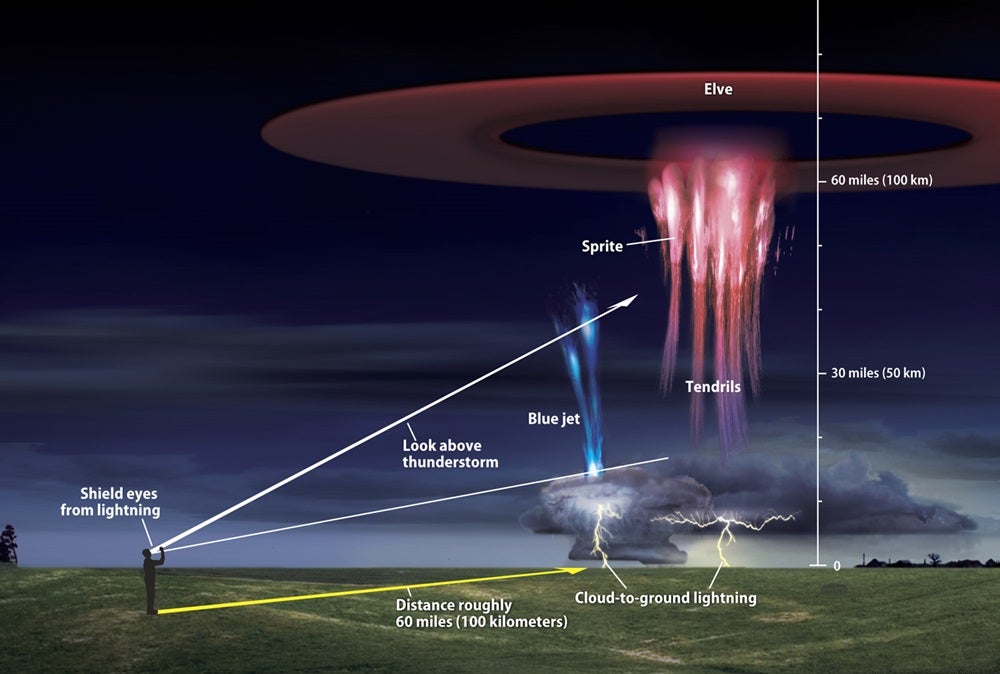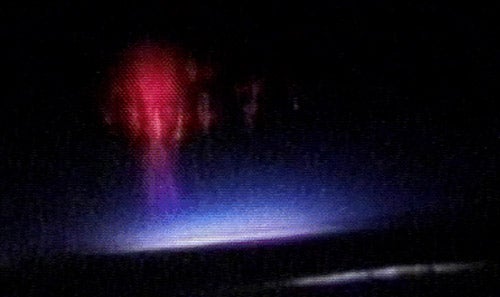Summer is upon us. With it comes the promise of hot days and, occasionally, sky-splitting lightning. But did you know that, under the right conditions, distant thunderstorms can also produce an array of eerie light spectacles?
These displays, called transient luminous events (TLE), form above the storms against a starlit nighttime sky. They appear as whimsical phantom shapes — doughnuts, trees, comet tails, and jellyfish, for example — that flash in and out of view in the blink of an eye. Seeing one has caused some observers (including me) to rub their eyes in disbelief.
But trust me, they’re there! Amateur astronomers and astronauts alike have spied them. Thousands have appeared in photographic and video documentation. They literally materialize and vanish, out of and into thin air, in the middle and upper atmosphere. And with a little planning and luck, you too just might see (or image) one or more of these phantasmagorical light shows. They play with not just the sky, but also your mind.
The TLE zoo

TLE researchers at the University of Alaska in Fairbanks have classified several events based on their appearances. Here are some of the most popular phenomena:
“Red sprites” appear in the sky as inverted teardrop-shaped bodies, below which hang blue filamentary “tendrils.” The most complex and dramatic TLE, sprites occur directly above active thunderstorm systems, to altitudes up to around 60 miles (100 kilometers). They are coincident with large, positive cloud-to-ground lightning strokes. Most sprites occur in clusters of two or more, giving them a shape reminiscent of a jellyfish, carrots, or a burning tree. The events last for only a few milliseconds, thus appropriately reflecting their namesake: the whimsical and fleeting air spirit Ariel in Shakespeare’s The Tempest.
“Sprite halos” are diffuse rose-colored glows that occasionally surround the bright cores of sprites. Halos may also precede sprites, lasting but a millisecond.
“Gigantic jets” resemble sprites, but they’re not directly associated with cloud-to-ground lightning. Instead, they tend to propagate upward from the core of oceanic thunderstorms. Gigantic jets are among the brightest TLEs and can last nearly a full second.
“Elves” appear as rapidly expanding doughnuts of light that vanish in less than a millisecond. They most likely result when an electromagnetic pulse from an energetic cloud-to-ground lightning strike propagates into the ionosphere. While elves may accompany sprites, the mechanisms that create the two differ.
“Blue jets” look like long and fanning comet tails that flash upward from the top of a thunderhead (from the electrically active core) at speeds of about 60 miles (100 km) per second. Each event lasts a few tenths of a second — a long time compared to sprite-related events. They’re also brighter than red sprites. Lightning doesn’t seem to trigger them directly, but they do have a strong correlation with hail activity in thunderstorms.
“Trolls” resemble blue jets, but are red and appear after tendrils of strong sprites extend downward toward the cloud tops.
Personal accounts

I saw my first TLEs December 5, 2005, from my home in Volcano, Hawaii. After a severe thunderstorm awakened me at 3:30 a.m., I went outside and saw crystal-clear skies. But every 5 to 10 seconds, I also saw flashes illuminate a band of clouds 10° above the southeastern horizon. Blocking the flashes with my arms, I looked at the stars about halfway up the sky. After 10 minutes, I suddenly saw a phantom jellyfish, 15° in length, flash in and out of view. I perceived no color in this sprite. Most curiously, although the physics behind the phenomenon suggests it lasts for just a few milliseconds, the visual/mental impression against the sky seemed to linger for about 1.5 seconds.
Five minutes later, as I looked about one-third of the way above the eastern horizon, another flash occurred. I saw an afterimage of my retina projected against the stars. But I also observed, to its lower right, a distinct flare of blue light, which formed a ball about 1° in apparent diameter. No other events occurred in the half-hour of observing.
More recently, on the evening of November 11-12, 2009, yet another distant thunderstorm (which threatened to dump snow and hail on Mauna Kea) produced broad flashes that appeared as a pretty pastel-blue dome above my northern tree line. Occasionally, three blue “comet tails” 15° long would appear in concert with the dome, looking like auroral streamers.
Were these blue jets? I don’t know. I didn’t see them dash upward, just their long forms connected to the blue dome. So perhaps they’re some other freakish phenomenon. The same storm produced a little blue crescent of light, about 1° in diameter, which I saw with direct vision just east of the North Star.
Summer and winter displays
During five separate winter thunderstorms (December 2005 through March 2006) in Israel and the Eastern Mediterranean Sea, Michal Ganot of Tel Aviv University and her colleagues detected 27 sprites (four halo sprites) and four elves. The sprites occurred almost exclusively over the sea, at altitudes between 27 and 65 miles (44 to 105 km). Most were single columns (like the “jellyfish” I had ob-served) and lasted, on average, about 43 milliseconds. Most of the thunderclouds that produced sprites were isolated cumulonimbus cells embedded within a matrix of lower rain clouds.
These observations support those by Taiwanese researcher Yun-Ching Wang of the National Cheng Kung University and colleagues. Since 2001, they’ve conducted yearly summer TLE campaigns from various locations in Taiwan. Up to 2005, their data indicate that land sprites tend to cluster while oceanic sprites tend to appear in a single column. Two extremely bright sprites were intense enough to cast reflections on the ocean or penetrate the intense light pollution of Taiwan’s city Tainan. On the remarkable night of July 22, 2002, they also recorded 5 gigantic jets. They lasted 300 to 500 milliseconds and appeared above an oceanic thunderstorm near the Philippines.
TLE research has made truly astounding progress in recent years. If you ever witness one of these eerie flashes, be sure to report it to TLE researcher Matt Heavner of the University of Alaska Southeast at http://elf.gi.alaska.edu. Of course, you should also send it to me at someara@interpac.net.









